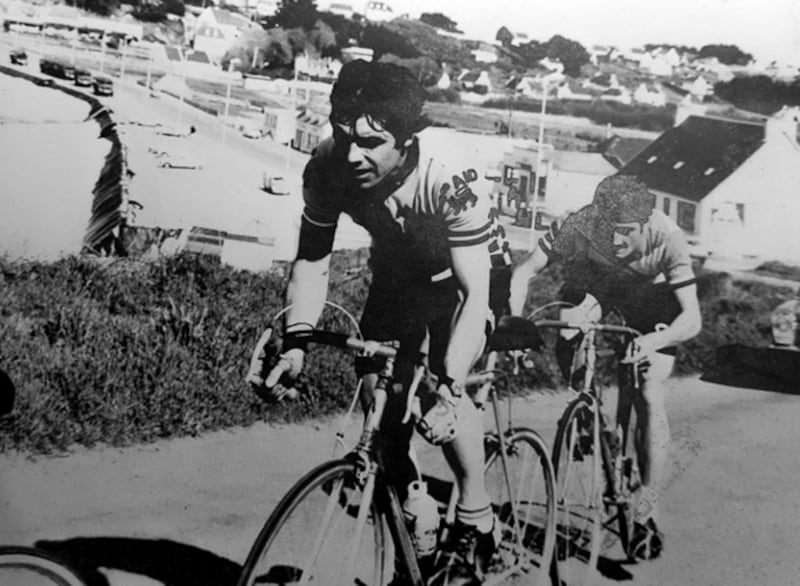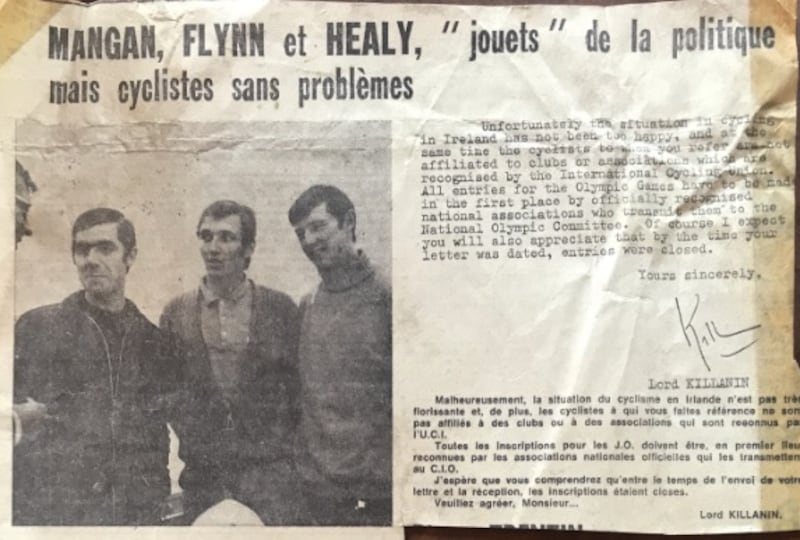This story is part of a series, The Greatest Irish Olympic Stories Never Told, which will run every Saturday in The Irish Times up to the beginning of the 2024 Olympic Games, on Friday, July 26th
Seven Irish cyclists and three support staff quietly slipped into the Belgian port of Ostend in August 1972 about a week before the Olympic Games were due to begin. Cars waited to collect the team and transport them to Munich to a secret address in the city where they had arranged to stay.
There was just one problem. None of the seven athletes travelling to Germany were part of the official Irish team. Noel Teggart, Peter Doyle, Liam Horner and Kieron McQuaid had been selected to compete in that year’s games.
The seven in Ostend had come for another purpose – to cause havoc and disrupt the road race on the world’s biggest sporting stage, the Olympic Games.
RM Block
Among the seven disrupters was Killorglin’s John Mangan, a well-known and hugely successful cyclist of the time. As he explained in an RTÉ radio documentary aired in 2020 called Green and Gold, the cars took more than a day to reach Munich, finally depositing the riders at a house in the city at 49 Implerstrasse.
There they stayed and trained low key until September 6th, the scheduled start date of the road race.
“We arrived a day before the Olympics and stayed in a house Eddie Rafter had organised,” explained Mangan. “When we went to do the protest, nobody brought the address [with them], so they could never trace where we were staying.”
Mangan and the other riders on the alternative team represented one side of Irish cycling’s bitter civil war, which had taken the fight to the Olympic Games as far back as Melbourne in 1956, a games that resonates with Ireland because of Ronnie Delany’s gold medal win in the 1,500m.
There, Paudie Fitzgerald, Tom Gerrard and Tom Flanagan made world headlines after they were arrested gatecrashing the road race. Sixteen years later in Munich the enmities still burned with the politics of the sport in a constant state of acrimony.
Cycling, after the foundation of the Irish State, had fractured into an alphabet soup of three hostile factions. There were two internationally-recognised bodies and another, the National Cycling Association (NCA), a 32-county organisation with members from all over Ireland, that was not recognised by the international federation.
The cyclists officially representing Ireland in Munich came from the Irish Cycling Federation (ICF), a 26-county organisation with members from the Republic of Ireland and the Northern Irish Cycling Federation (NICF), a six-county organisation, with members from Northern Ireland.
The seven who had surreptitiously made their way to Munich were all NCA members.

Their plan was simple and tailored for the relatively low level of security at the event – disrupt the race, cause chaos, most likely get arrested and generate headlines about their plight and more widely about Britain’s role in Irish affairs.
The atmosphere in Northern Ireland at the time was febrile. Earlier in the year, British soldiers from the Parachute regiment shot 26 unarmed civilians during a protest march in the Bogside area of Derry. In what became known as Bloody Sunday, 13 people were killed outright, six of them 17 years old, with another man dying four months later from his injuries.
It was a year in which violence reached new heights, with 1972 earning the ignominious title of being the bloodiest year of the Troubles.
[ The day of rage after Bloody Sunday that saw the British embassy burn downOpens in new window ]
Reacting to the Derry massacre, a crowd marched to the British embassy in Dublin on February 2nd. What was supposed to have been a day of mourning in the city for the victims turned into a day of rage and the embassy was burned down. Mangan had taken part in the Dublin march and watched as the building in Merrion Square was gutted.
The arrival of the NCA members also coincided with a change in the tone West Germany had towards the Olympic Games.
That year, the country had opted to present a softer side and move away from the images cast around the world at the 1936 Olympics, which had been usurped and dominated by the rise of Hitler’s Nazi regime. Munich’s motto in 1972 was “Heitere Spiele” – the Cheerful Games.
But even before the NCA activists arrived on mainland Europe, protests and factional fighting between the three organisations were commonplace in Ireland, where they held separate racing events. At that year’s Tour of Ireland, which was run several weeks before the Olympics began, the course had been sabotaged at various points. Parts of the route were seeded with tacks causing tyres to puncture and at another location oil was dangerously spread across the surface of the road.
The Munich job, according to Mangan, was organised by Joe Christle, a UCD law graduate and well known Irish Republican, who died in 1998. Christle was a successful cyclist and the father of three well-known champion Irish boxers, Terri, Joe and Mel. The plan was hatched in the last couple of days of that year’s Tour of Ireland race.
“He gave us the details of where we would be going,” said Mangan.

The strategy for disrupting the Olympic race involved splitting the riders into two groups. They sent four of the seven to the start of the race, where they casually mingled with the other competitors, hoping not to be noticed. When the race began their aim was to remain in it for as long as possible competing against the official riders.
The three other riders were instructed to hide in a stand of trees further out the race route and join the four starters as the peloton passed their position.
It was simple enough, but the Irish protest was not without an element of farce. On race day, the three riders positioned themselves in the trees and the nominated four went to the start line at Grunwald. The ones at the race start arrived to find that none of the expected 163 starters from 48 nations were there. The place was deserted.
So low-key and removed had the team been while holed up at 49 Implerstrasse that they had not heard the unfolding news and the declared 24-hour period of mourning for the victims of the previous Tuesday’s attack, and the killing of six Israeli coaches and five athletes. The International Olympic Committee (IOC) had refused to cancel the games but they had called for a day of mourning. The road race had been deferred for 24 hours until September 7th at 10am local time.
The Irish Times report of more than 50 years ago described the general confusion.
“The protesters, unaware of the change in schedule, took up their places in the ditch at 7am on the Wednesday and hid there for some four hours until the harsh truth began to dawn that their sabotage operation had gone astray,” it said.
Although the NCA riders insisted they were briefed to keep the protest peaceful, the account in The Irish Times described scuffles breaking out at the start of the race the following day as leaflets were distributed protesting against the British occupation in Ireland. But one of the cyclists, Pat Healy, avoided detection.
The report continues: “Four cyclists, Gabriel Howard, Pat Healy, TP Reilly and a Belfast rider who refused to be named, went to the line in white singlets, emblazoned with a Tricolour band.
“Further down the road, three more protesters, John Mangan, Batty Flynn and another Belfast man, who had hidden in a ditch since 7.00am, joined the race as it passed and Flynn caused absolute consternation by catching the main group and leading them, opening up a 10-yard lead.

“An unnumbered competitor was scarcely designed to ease the problems of either commentators or race officials and within another five miles, the Kerryman [Flynn] was taken forcibly out of the field by police on motorcycles. For the next two laps we had the bizarre spectacle of two Irish teams in the race.”
Mangan takes up the story: “I joined the Olympics maybe four or five miles out the road. I attacked. I led the Olympics for a good few miles and the only fella who was able to stay with me was the Russian.”
The protest did gain international attention. But it also had devastating consequences for the official Team Ireland riders, particularly Teggart, who became involved in a heated row with Mangan. It resulted in Teggart falling from his bike and it ended his international career.
“He had his view, I had my view,” said Mangan. “We talked about it in the future. He was a nice man. We made our peace. I think the poor man died a year or two later. It would have been better if it ended another way.
“He could have finished his race and I could have finished my race.”
One of the Belfast riders, 19-year-old Brian Holmes, was arrested shortly after returning home and spent three years in Long Kesh. In a 2020 interview with the Irish News he said he had no regrets about his place in Olympic history.
“It took a while after that for Irish cycling to become one,” he said. “I have no regrets. I would do the same thing in the morning. We were condemned for bringing politics into sport. It was okay for a big nation to protest, for example Maggie Thatcher refusing to send athletes to Russia in 1980.”
Cycling Ireland now represents cyclists on the island of Ireland with members able to opt for their preferred nationality, preserving political and cultural identities.






















